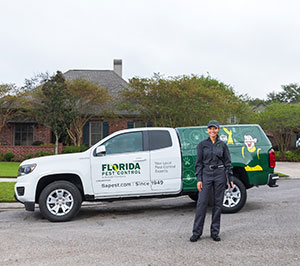Bed Pest Therapy Failure: Contrasting Chemical Vs. Non-Chemical Solutions
In the realm of insect control, especially when taking care of the persistent concern of bed insects, the option between chemical and non-chemical treatment options can be a critical one. Both strategies provide distinct benefits and drawbacks, affecting variables such as performance, safety factors to consider, and total cost. By checking out the nuanced details of each approach, a clearer understanding of which course to seek in resolving a bed bug infestation can be obtained.
Effectiveness of Chemical Treatments
Chemical therapies for bed insect problems have been widely recognized for their potent and fast efficiency in getting rid of these bugs. When thinking about the performance of chemical treatments, it is critical to understand that they can supply a complete and fast service to a bed bug issue. Specialist pest control men usually depend on pesticides to target bed bugs at various phases of their life cycle, consisting of grownups, eggs, and nymphs. These chemicals normally work by interrupting the bed pests' nerve system, bring about paralysis and ultimate fatality.
Moreover, chemical treatments have the benefit of providing residual impacts, implying that they can continue to get rid of bed pests even after the first application. This residual action is particularly beneficial in combating any kind of potential re-infestations. Furthermore, the fast action of chemical therapies can bring relief to people encountering serious bed bug infestations, allowing them to reclaim control of their space rapidly.
Safety And Security Interest In Chemical Solutions
When using chemical services for bed pest treatment is ensuring the security of residents and the setting,One important facet that requires careful factor to consider. While chemical treatments can be efficient in removing bed bugs, they may present dangers otherwise dealt with properly. Among the main security problems with chemical options is the potential injury they can trigger to human health and wellness. Direct exposure to specific chemicals used in bed insect therapies can lead to breathing concerns, skin irritation, or other adverse reactions, specifically in people with pre-existing problems or sensitivities. Furthermore, improper application or dosage of chemical pesticides can cause poisonous deposits lingering in the treated area, positioning long-lasting wellness risks to residents.
In addition, the ecological impact of chemical services is an additional substantial consideration. Some pesticides used in bed pest treatments might be harmful to helpful insects, wildlife, and ecological communities if they leach right into the dirt or water supply. It is important to use chemical treatments carefully, following safety standards, and considering much less hazardous alternatives to reduce these dangers and make sure the safe and effective monitoring of bed pest problems.
Benefits of Non-Chemical Techniques
Considering the potential safety worries and environmental impact connected with chemical remedies for bed bug treatment, discovering non-chemical methods offers a promising choice with a number of unique benefits. Non-chemical methods provide a more secure option for houses, especially those with family pets, people, or kids conscious rough chemicals. These methods get rid of the threats of direct exposure to harmful compounds, decreasing the possibility for unfavorable health impacts. In addition, non-chemical therapies are environmentally friendly, as they do not add to air or water air pollution, making them a lasting option for insect control.
In addition, non-chemical remedies can be efficient in targeting bed insects, consisting of hard-to-reach locations where More Bonuses chemical treatments may not permeate. Techniques such as heat therapy, vacuuming, steam cleansing, and bed mattress coverings supply detailed elimination without using dangerous chemicals. Additionally, non-chemical strategies can be much less turbulent, needing marginal prep work and permitting quicker reentry into dealt with areas. On the whole, choosing for non-chemical bed bug therapy methods not just prioritizes safety and security and environmental management but additionally makes certain comprehensive and efficient pest control.
Limitations of Non-Chemical Treatments

In addition, non-chemical treatments frequently require several applications to accomplish successful eradication. This can be time-consuming and may not constantly guarantee total removal of all bed pests and their eggs, especially in hard-to-reach or covert places.
Moreover, the success of non-chemical therapies heavily relies on proper implementation and thoroughness, which can be challenging for individuals without professional experience. Inadequate application of non-chemical techniques might lead to incomplete removal, resulting in relentless infestations and the demand for additional treatments.
For that reason, while non-chemical treatments have their advantages, it is important to recognize these restrictions and consider them when identifying one of the most reliable technique for managing bed bug infestations.
Expense Comparison: Chemical Vs. Non-Chemical Options
Given the limitations linked with non-chemical treatments, a crucial aspect to assess in the context of bed insect management is the expense comparison in between chemical and non-chemical options. Chemical treatments generally entail the application of insecticides by professionals, which can official source vary from $250 to $900 per space, depending on the severity of the infestation and the dimension of the location to be treated. On the other hand, non-chemical therapies like warm therapy or steam can be more pricey, with prices varying from $1,000 to $6,000 for an entire home. While the initial cost of chemical treatments may seem lower, several therapies might be required to totally eliminate the problem, possibly increasing the total cost. On the various other hand, non-chemical choices may provide a more eco-friendly and sustainable service, although they can be cost-prohibitive for some individuals. Ultimately, when taking into consideration the price of bed pest treatment options, it is very important to evaluate the ahead of time costs against the effectiveness and long-term sustainability of the from this source chosen method.
Verdict

Thinking about the prospective safety and security issues and environmental effect associated with chemical solutions for bed bug treatment, discovering non-chemical methods presents an appealing choice with several unique benefits.Provided the limitations linked with non-chemical treatments, a vital facet to review in the context of bed insect administration is the cost contrast between chemical and non-chemical alternatives. In contrast, non-chemical treatments like warmth therapy or vapor can be more pricey, with costs varying from $1,000 to $6,000 for a whole home. While the first price of chemical treatments may seem reduced, numerous therapies may be required to totally eradicate the problem, potentially increasing the overall expense.In conclusion, when contrasting chemical and non-chemical bed bug treatment choices, it is important to think about efficiency, security, benefits, restrictions, and expense.